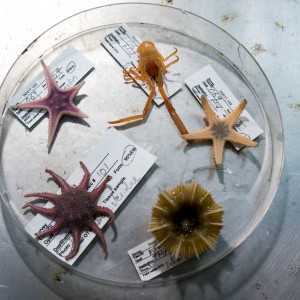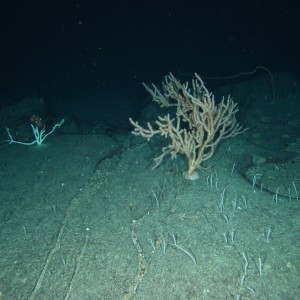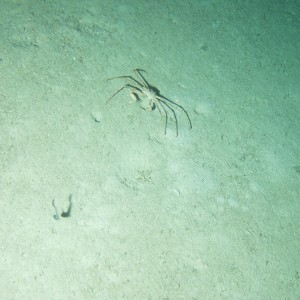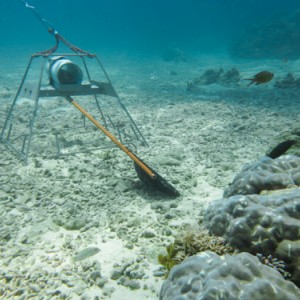AMPS Atlas
This is a compilation of all the images in this Atlas. To access images from particular marine parks, navigate to the image gallery on each marine park page.
A black tree coral on Joe's Reef, Freycinet Marine Park, dwarfs the diverse sponge and invertebrate community beneath it. Black corals are named after the black colour of their skeleton, and their living tissue can take on a variety of bright colours, including white.
 by James Parkinson
by James ParkinsonThe boundary between sand habitat (on the right) and low profile reef habitat (on the left) in 90 metres depth in the Freycinet Marine Park. The boundary is marked by a distinct change in slope and a change from bare sand to a sandy/invertebrate turf cover. It is also often demarcated by dense clusters of brittle stars, potentially due to enhanced food availability due to enhanced current speeds or accumulation of detritus at the reef base. Generally these “relict coastline” reefs are very low profile as shown here, and have quite low invertebrate cover with few larger sponges.
 by Institute of Marine and Antarctic Studies
by Institute of Marine and Antarctic StudiesRV Challenger at the CSIRO wharf in Hobart ready for June 2012 Flinders Marine Park survey, with Baited under water video (shallow), Deep-water CSIRO Baited underwater video (topped with brightly coloured floats), plus the CSIRO Towed Video system. This NERP Hub cruise deployed baited underwater video and towed video over previously mapped seabed within the Flinders Marine Park to quantitatively determine the distribution of species and habitats within the shelf and upper slope of the Marine Park based on a GRTS-based statistical framework for spatially balanced sampling and inference.
 by Institute of Marine and Antarctic Studies, CSIRO
by Institute of Marine and Antarctic Studies, CSIROA small blenny (Ecsenius yaeyamaensis) on a massive coral. There are over 300 known species of blennies globally, most of which are restricted to tropical regions with only a few found in cool-temperate waters. Blennies are small bottowm-dwelling fish, and this particular species is commonly observed in shallow coastal reefs where it perches on boulders and live coral heads in areas of abundant coral growth.
 by Reef Life Survey
by Reef Life SurveyA screenshot of a sub-bottom profile collected int the Oceanic Shoals Marine Park. It shows a layered sediment (mud and sand) that has partly buried by a carbonate bank (bottom right corner). The length of the image is approximately 7.5 km, and the depth of the ocean floor is 100 m.
 by Geoscience Australia
by Geoscience AustraliaIn 2009 JASON Remotely Operated Vehicle (ROV) (belonging to the Woods Hole Oceanographic Institution) undertook a voyage in the Tasman Fracture Zone off south-east Tasmania. This is a still image taken at 4006 metres showing deep water stalked carnivorous ascidian (Family Octacnemidae) approximately 50 centimetres in height. The ascidian works similar to a venus fly-trap, using the funnel-like appendage to collapse around prey that move past.
 by CSIRO
by CSIROAdjusting an autonomous underwater vehicle at sunrise
 by Asher Flatt
by Asher FlattOnboard observers scan the ocean surface in search of wildlife during aerial surveys. Left to right: Verity Steptoe, Rebecca Wellard.
A large bamboo coral from the Huon Marine Park (1146 m depth). In this region these corals can grow to at least 2 metres tall and live for at least 370 years.
 by CSIRO
by CSIROTechnical diver Andreas Klocker next to a black coral on Joe's Reef, Freycinet Marine Park.
 by James Parkinson
by James ParkinsonLaunching an Integrated Marine Observing System autonomous underwater vehicle in Flinders Marine Park.
 by Institute of Marine and Antarctic Studies
by Institute of Marine and Antarctic StudiesA still image of the benthos taken from an AUV in the Flinders Marine Park.
 by Institute of Marine and Antarctic Studies
by Institute of Marine and Antarctic StudiesSenior field technicians Jem Turner, Louis Masarei and Adam Jolly prepare baited camera equiptment before deployment in the Bremer Marine Park.
A Baited Remote Underwater Video System (BRUVS) sits on the seafloor, recording the species of marine fauna that are attracted to the bait attached to the extended arm. BRUVS are a low-impact sampling technique that are particularly useful in observing fish in hard-to-reach areas, deep and dangerous waters inaccessible to divers, and at night. They are also advantageous because they can be deployed in fleets over large areas, and record shy species such as sharks, rays and snakes that normally avoid scuba divers and towed videos.
Senior field technician Jem Turner prepares baited camera equiptment before deployment in the Bremer Marine Park.

Patience seamount is the only seamount off temperate Australia where the abundant basketwork eel spawns (1092 metres depth). The eels co-exist there with schools of orange roughy.
 by CSIRO
by CSIROThis benthic community including brittle stars, was captured by on an AUV survey.
 by IMOS, AUV Sirius
by IMOS, AUV SiriusExamples of what was found in the benthic sleds. Top: RV Solander crew release the sample from the sled net into the sorting tray on deck. Left: A sled dominated by feather stars, brittle stars and sea stars. Right: A sled dominated by sponges and soft corals
A huge black coral at Joes reef, Tasmania, surrounded by a school of perch.
 by James Parkinson
by James ParkinsonA blotched fantail ray (Taeniurops meyeni) and the guitar fish is Rhynchobatus sp., attracted to the camera by a baited steel arm on a BRUV system. This BRUV was deployed by researchers at the Australian Institute of Marine Science and Global Finprint program in an effort to monitor the impact of the crack-down on illegal fishing on the shark population at Ashmore Reef.
Aerial view of a boat speeding near the Abrolhos Marine Park off the off the coast of Western Australia.
 by Parks Australia
by Parks AustraliaStill image of hard coral taken during underwater visual census surveys in the Houtman Abrolhos islands of Western Australia in 2008 as part of the Reef Life Survey program. The Reef Life Survey program is a volunteer network of highly trained divers, and is a product of the CERF Major Projects funding that facilitated a cost-effective citizen science contribution to inventory and monitoring of shallow water marine environments. The RLS program has been further facilitated within the NERP Hub, describing biodiversity patterns at a national and global scale, as well as providing critical baseline data from areas such as the Coral Sea Marine Park, from Ashmore Reef, the Great Barrier Reef,and other Australian Marine Park such as the Cod Grounds.
 by Reef Life Survey
by Reef Life SurveySeamounts provide hard, elevated and current-swept habitats that create a hotspot of species diversity and abundance. Here sea stars, feather stars, soft corals, glass sponges and sea urchins live among a thicket of stony corals and sea whips (1106 metres depth).
 by CSIRO
by CSIROBrisinglid sea stars photographed in the Coral Sea as part of the Deep Down Under research expedition. The Deep Down Under expedition was a team of German and Australian researchers exploring deep into the waters of Australia's Coral Sea in 2009. Geobiologists from the Ludwig-Maximilians-Universität Munich, the Natural History Museum at the Humboldt-Universität Berlin, the University of Göttingen, the Queensland Museum, University of Queensland and James Cook University investigated ‘living fossils’ such as sponges, brachiopods, echinoderms and cold-water corals in the deep. Using a 1000 m-rated Cherokee ROV from MARUM at the University of Bremen, the team explored the deep-sea ecosystems on the steep slopes of Queensland Plateau emergent reefs, such as Osprey Reef, which have remained largely unchanged for millions of years.
























